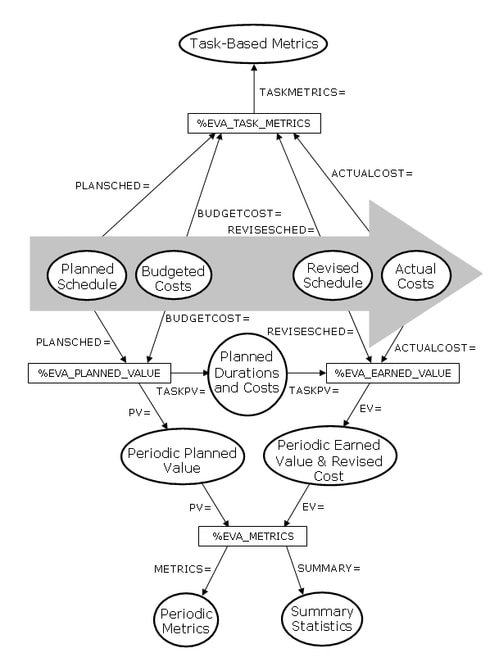The Earned Value Management Macros
%EVA_PLANNED_VALUE
This macro is used to produce the periodic planned value.
%EVA_PLANNED_VALUE ( parameters ) ;
Required Parameters
- ACTIVITY= variable
-
specifies the activity variable in the PLANSCHED= and BUDGETCOST= data sets.
- BUDGETCOST= SAS-data-set
- PLANCOST=SAS-data-set
-
identifies the input data set containing the budgeted cost rates for each activity.
- PLANSCHED= SAS-data-set
-
identifies the input data set containing the planned schedule.
- START= variable
-
specifies the start date or datetime variable in the PLANSCHED= data set.
Figure 11.29: Analysis Macro Data Flow

Optional Parameters
- CALENDAR= SAS-data-set
-
identifies the calendar input data set. (See the CALENDAR= option in Chapter 4 for more details.)
- COST= variable
-
specifies the cost variable in the BUDGETCOST= data set. This is the total of the start and finish costs associated with the given task. At least COST= or RATE= must be specified.
- DURATION= variable
-
specifies the task duration variable in the PLANSCHED= data set. At least DURATION= or FINISH= must be specified. If both parameters are specified, the FINISH= variable value overrides a nonzero DURATION= variable value; i.e., duration is only used to indicate a milestone task.
- FINISH= variable
-
specifies the finish date or datetime variable in the PLANSCHED= data set. At least FINISH= or DURATION= must be specified. If both parameters are specified, the FINISH= variable value overrides a nonzero DURATION= variable value; i.e., duration is only used to indicate a milestone task.
- HOLIDATA= SAS-data-set
-
identifies the input data set that contains the holiday schedule. (See the HOLIDATA= option in Chapter 4 for more details.)
- HOLIDAY= statement
-
specifies the HOLIDAY statement to use for PROC CPM. For example:
%eva_planned_value(\ldots, holiday=holiday start / holifin=finish, ...);
(See the HOLIDAY statement in Chapter 4 for more details.)
- INTERVAL= interval
-
specifies the units to use for the DURATION= variable values. (See the INTERVAL= option in Chapter 4 for more details.)
- MAXOBS= max
-
sets the limit on the number of allowable observations for the PV= data set. (See the MAXOBS= option of the RESOURCE statement and CPM procedure in Chapter 4 for more details.)
- NROUTCAL= variable
-
indicates which calendar is to be used for incrementing the _TIME_ variable in the BCOSTOUT= data set. (See the NROUTCAL= option of the RESOURCE statement and CPM procedure in Chapter 4 for more details.)
- PV= SAS-data-set
-
identifies the output data set that contains the periodic planned value. The frequency is determined by the INTERVAL= and ROUTINTERVAL= parameters. The default data set name is
PV. - RATE= variable
-
specifies the cost rate variable in the BUDGETCOST= data set. This is the rate at which cost is incurred over the duration of the task. The variable that contains this duration is specified with the DURATION= parameter. At least RATE= or COST= must be specified.
- ROUTINTERVAL= interval
-
specifies the period between values in the PV= data set. (See the ROUTINTERVAL= option in Chapter 4 for more details.)
- SPCT= variable
-
specifies the start percentage variable in the BUDGETCOST= data set. This is the percentage of the COST= amount that is incurred at the beginning of the task. The default is zero, in which case the entire COST= amount is incurred at the completion of the task. The specified variable may also contain a comma-delimited list of weights to be used for distributing the cost at equal working intervals over the duration of the activity.
- TASKPV= SAS-data-set
-
identifies the output data set that is used as input to the %EVA_EARNED_VALUE macro. This data set is used to store the planned duration and costs by activity, which are used by the %EVA_EARNED_VALUE macro to compute earned value (see Figure 11.29). The default data set name is
TASKPV. - WORKDAY= SAS-data-set
-
identifies the workday input data set. (See the WORKDAY= option in Chapter 4 for more details.)
Note that if a WORKDAY=, CALENDAR=, or HOLIDAY= data set is specified, the default variable name,
_CAL_, is assumed for calendar identification.Table 11.1 summarizes the parameters used for managing input and output data sets in the %EVA_PLANNED_VALUE macro.
Table 11.1: %EVA_PLANNED_VALUE I/O Parameter Summary
Type
Data Set
Variables
INPUT
BUDGETCOST
COST, RATE, SPCT
INPUT
CALENDAR
INPUT
HOLIDATA
INPUT
PLANSCHED
ACTIVITY, DURATION, FINISH, START
INPUT
WORKDAY
OUTPUT
PV
OUTPUT
TASKPV
